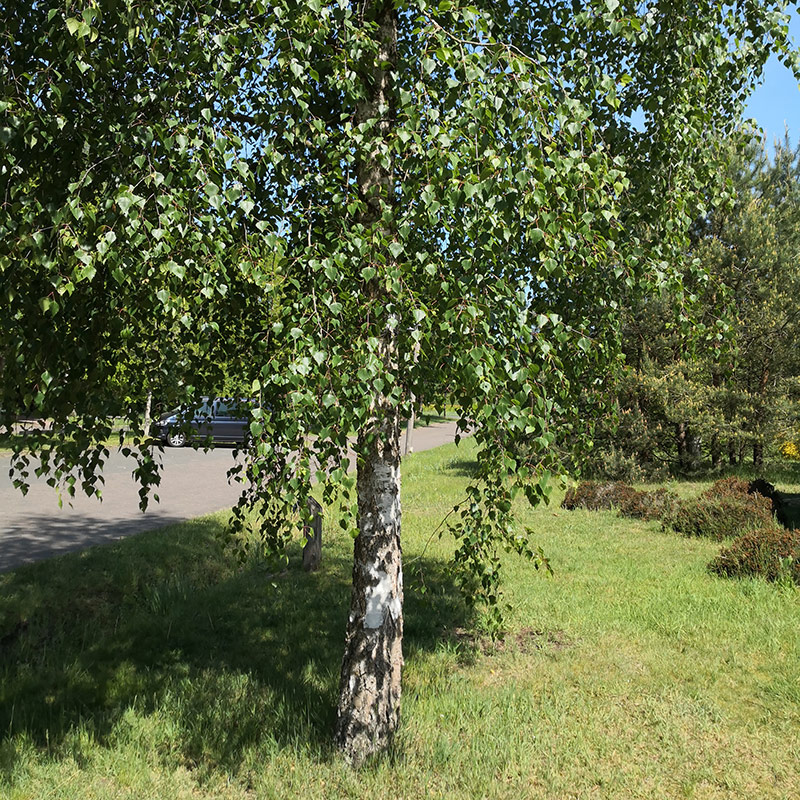Botanical name
Betula pendula Roth
Family
Betulaceae
Common name
Birch, Silver birch, Common birch, Warty birch
Information about the plant
Of the birches native to northern and central Europe as far as Siberia, the silver or warty birch (also known as white birch) is the most common in central Europe. It tolerates hard frosts and poor soils, and copes well with drought. It grows very quickly into a tree, up to 30 m high, with a dominant trunk and widely overhanging branches. Characteristic of all birches is the white bark of the trunk, which can be peeled off horizontally as thin as paper. This white color is caused by betulin embedded in the bark.
It is assumed that the name "birch" is derived from the Indo-Germanic 'bhereo' (= shiny, white). The genus name Betula comes from the Latin 'bitumen' (= earth pitch, asphalt) because the Gauls made a type of bitumen from the birch sap (Gallic betu = resin, rubber, glue). The species epithet pendula (Latin 'pendulus' = hanging/pendulous) refers to the pendulous male inflorescences (catkins) up to 10 cm long and/or the pendulous branches. The female inflorescences are erect at flowering time, only later pendulous and up to 4 cm long. Flowering time is from April to May. Leaves are typically rhombic and long-pointed with double-toothed leaf margins.
The downy birch (Betula pubescens Ehrh.) is also medicinally used; its leaves are somewhat smaller.
Medicinally used parts of plants (herbal drug)
The foliage leaves (birch leaves - Betulae folium) and the cork-free bark (Betulae cortex) are used.
The commercially available leaf drug comes from China, Russia, Poland and other Eastern European countries. The birch bark is used industrially for the production of extracts.
Constituents of the herbal drug
Birch leaves: flavonoids and other polyphenols.
Birch bark: betulin (triterpenes).
Quality of the drug
The quality of birch leaves (Betulae folium) is specified in the European Pharmacopoeia (Ph. Eur.). According to the pharmacopoeia, the leaves of the downy birch (Betula pubescens) may also be used, as well as hybrids of B. pendula and B. pubescens.
There is no official quality description for birch bark.
Medical applications
Recognised medical use
Birch leaves
The HMPC has classified birch leaves as a traditional herbal medicinal product (see Traditional Use).
ESCOP: Urinary tract irrigation, especially in cases of inflammation and renal gravel, and as an adjuvant in the treatment of bacterial infections of the urinary tract.
Commission E: irrigation therapy for bacterial and inflammatory diseases of the urinary tract and for kidney stones; supportive therapy for rheumatic ailments.
Birch bark
For a long time, birch bark dry extract was only incorporated into skin care preparations; in 2016, a gel containing birch bark dry extract (72 to 88 mg betulin per g gel) received approval with the indication "Treatment of superficial skin wounds (epidermis and upper dermis) and grade IIa burn wounds of the skin in adults."
Traditional use
Birch leaves have been classified by the HMPC as a traditional herbal medicinal product (§ 39a AMG). Based on many years of experience, birch leaves can be used to increase the volume of urine and thus flush the urinary tract in cases of mild urinary tract problems.
Herbal drug preparations in finished dosage forms
Birch leaves
- Cut birch leaves for tea preparation.
- Dry extracts in tablets and soluble instant teas.
- Alcoholic extracts in juices.
- Fresh plant-pressed juice.
Dry extract (DEV 5-10:1; extraction agent heptane; equivalent to 72-88 mg betulin/g gel) in gels.
Dosage
Finished dosage form: see patient information leaflet.
Tea infusion: drink a cup of birch leach infusion several times a day. Maximum daily dose: 12 g of drug.
Preparation of a tea
Pour 150 ml of boiling water over 2 to 3 g of finely chopped birch leaves and strain after 10 to 15 min.
Notes
Birch pollen allergy sufferers should not use birch leaves.
During flushing therapy, it is necessary to drink plenty of fluids.
Birch leaves should not be used in febrile urinary tract infections and acute prostatitis, as well as in cases of water retention as a result of impaired kidney or heart activity.
For the use of birch leaves during pregnancy and lactation, no safety studies are yet available; use in children under 12 years is not recommended due to lack of evidence.
Side effects
Rarely mild gastrointestinal symptoms
Interactions
None known
References
Herbal drug monographs
Further literature
Commentary on the European Pharmacopoeia (Birch leaves, Nr. 1174)


